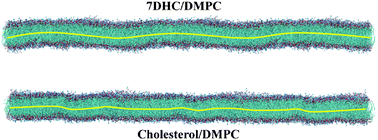Impact of sterol tilt on membrane bending rigidity in cholesterol and 7DHC-containing DMPC membranes†
Abstract

* Corresponding authors
a
Department of Physiology and Biophysics, Weill Medical College of Cornell University, Weill Cornell Medical College, 1300 York Avenue, room LC-501B, New York, NY, USA
E-mail:
gek2009@med.cornell.edu
Fax: +212-746-6226
Tel: +212-746-6539
b Institute of Biophysics and Nanosystems Research, Austrian Academy of Sciences, Graz, Austria
c Institute of Advanced Science and Technology, University of Illinois, Urbana, United States
d
Institute of Chemistry and the Fritz Haber Research Center, The Hebrew University of Jerusalem, Jerusalem, Israel
E-mail:
daniel@huji.ac.il
Fax: +972-2-6513742
Tel: +972-2-6585484

 Please wait while we load your content...
Something went wrong. Try again?
Please wait while we load your content...
Something went wrong. Try again?
G. Khelashvili, M. Rappolt, S. Chiu, G. Pabst and D. Harries, Soft Matter, 2011, 7, 10299 DOI: 10.1039/C1SM05937H
To request permission to reproduce material from this article, please go to the Copyright Clearance Center request page.
If you are an author contributing to an RSC publication, you do not need to request permission provided correct acknowledgement is given.
If you are the author of this article, you do not need to request permission to reproduce figures and diagrams provided correct acknowledgement is given. If you want to reproduce the whole article in a third-party publication (excluding your thesis/dissertation for which permission is not required) please go to the Copyright Clearance Center request page.
Read more about how to correctly acknowledge RSC content.
 Fetching data from CrossRef.
Fetching data from CrossRef.
This may take some time to load.
Loading related content
